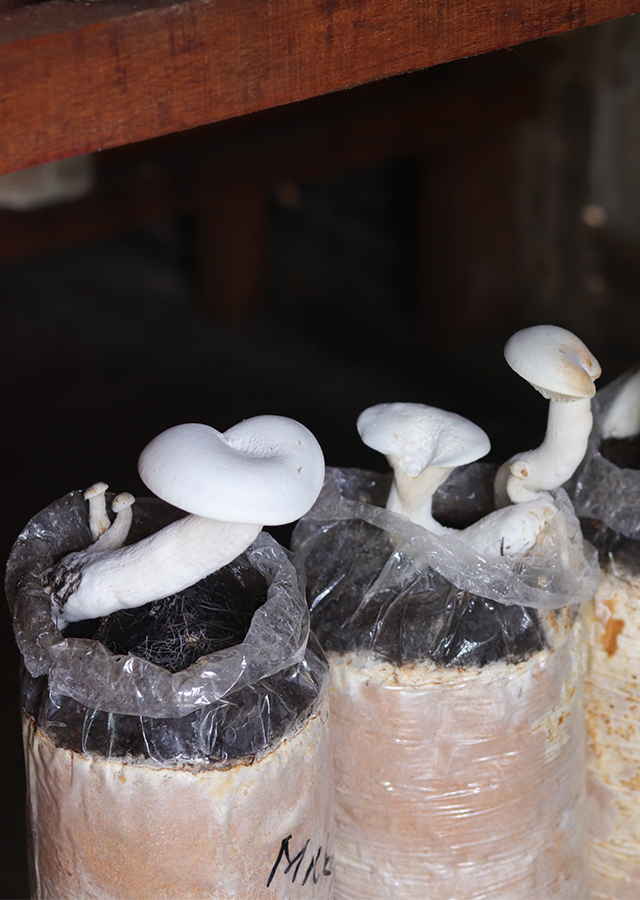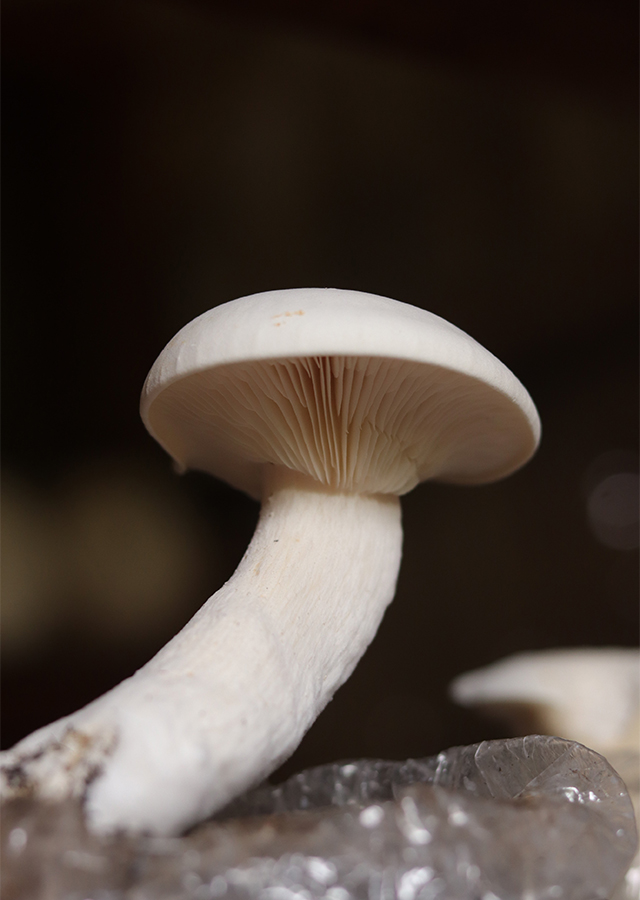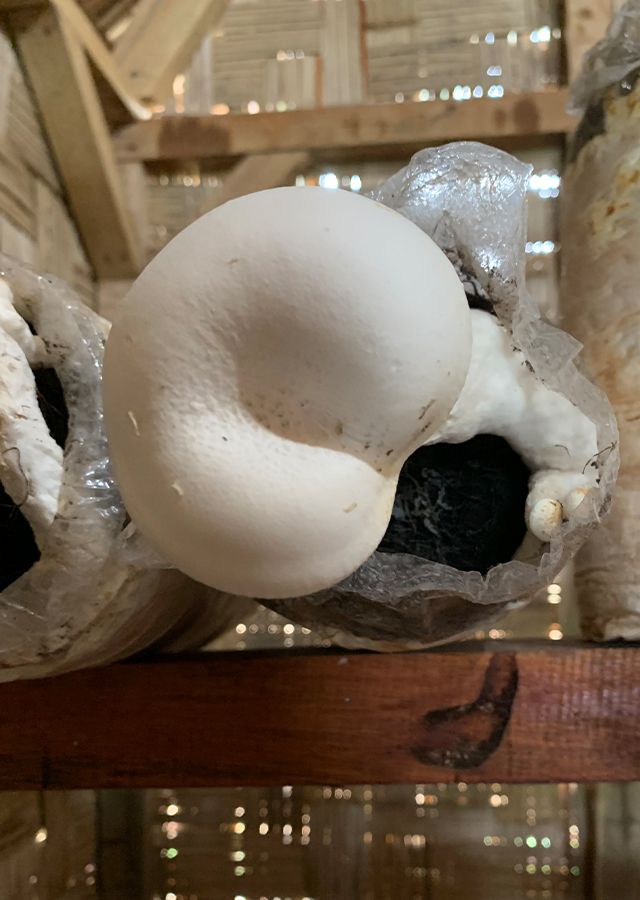Milky Mushroom
Calocybe indica Purkay. & Chandra
Lyophyllaceae
Location in our garden
Mushroom House



Synonym
-
Habitus
Herbaceous. Fungi, saprophytes
Part Used
The Whole Plant
Growing Requirements
Need Shade
Habitat
Roadside
Grassland
Overview
Milky mushroom is a species of mushroom native to India and is the fourth most widely grown mushroom in India, especially in Tamil Nadu. One of the mushrooms cultivated in summer and introduced by Purkayastha and Chandra in 1974. Commercially, this mushroom is widely cultivated in South India and is becoming more popular in China, Malaysia, Singapore and other tropical countries. Milky mushrooms are widely used by the community as a healthy food ingredient, where traditionally consumed by people in West Bengal. This mushroom is rich in protein and fiber, cholesterol free and low in fat. Besides being known as a nutritious food ingredient, this species is also known to have medicinal benefits. The results of the study revealed that milk mushrooms are very suitable and beneficial for maintaining health. This species can also be used for decolorization and waste remediation. So that it can be used to help improve the quality of wastewater discharged into rivers.
Vernacular Names
No information found. Need further search.
Agroecology
Milky mushroom is a hardy strain that grows fast and can grow on a variety of substrates, such as rice straw, rice husks, grass stalks and leaves, bagasse, corn cobs, tea or coffee waste, green beans and peanut shells, coconut husks, cardboard, even newspapers. This fungus can grow in hot humid countries (60% to 70%) with a temperature range of 25 - 35 °C throughout the year. In their country of origin, milky mushrooms are usually found growing in humus-rich soils, meadows, agricultural fields or along roadsides in tropical and subtropical parts of the world. This species go through two phases, namely the dark phase and the light phase. Where in the dark phase, mycelium development will occur and in the light phase the pin heads begin to grow. Mushrooms appear between May and August after the rainy season.
Morphology
- Fruit stalk (stipe) - fleshy, often tortuous, expanding or enlarged towards the base, smooth surface.
- Fruit body - milky white to pale yellowish white. The cap is 40 - 70 mm in diameter, wide convex, flattens as it grows or ages. The surface is initially white to yellowish white, becoming gray to grayish orange, smooth, glabrous.
- Gills - tortuous fringed narrow, white in color, filled with many lamellae.
- Spore - white.
Cultivation
Laboratory process: Fungal mycelium is transferred to bags of grains such as sorghum or corn. All procedures should be carried out under sterile culture. After growing, the mushroom seeds are then planted in the substrate.
Making mushroom bags: The substrate is soaked in fresh water for 8-16 hours to saturate the substrate with water. After soaking, pasteurization must be carried out to kill competing microbes and other organisms. The substrate was then air-dried for several hours. When the desired dryness is achieved, the seedlings are added in layers to the substrate in bags with about 20 small holes. The logs were then compressed, tied, and incubated at room temperature for 2 weeks.
After 2 weeks, the bag is sliced and a cover layer consisting of soil, carbonized rice husk, or a combination of both is added on top. After casing, let it stand in a shady place with normal room temperature and 80-90% relative humidity.
Mushroom fertilization requires a space that has little light.
Mushrooms can be harvested if the cap is fully open, but there is still a small indentation between the edge and the gills. Harvest by holding the stem and turning it lightly.
The shelf life of milky mushrooms lasts 7 days at room temperature, with refrigeration milky mushrooms will last for 20 days without significant loss of quality.
Chemical Constituents
Amino acids (alanine, aspartic acid, glutamine, glutamic acid, glycine hydroxyl proline, histidine, lysine, threonine, trirosine, valine, arginine and proline), thiamine, riboflavin, nicotinic acid, pyridoxine, biotin, ascorbic acid, phenolic compounds, terpenes and steroids.
Traditional Medicinal Uses
- Lowers bad cholesterol levels.
- Helps in treating diabetes.
- Treats constipation.
- Strengthens and regulates the immune system.
- Helps relieve asthma and other allergies.
- It has antihyperglycemic, antioxidant, antibiotic, antitumor and anticancer effects.
Part Used
Reference Sources
- EOL. Calocybe indica Purkay. & A. Chandra 1974. https://eol.org/pages/6683991/articles. 12-04-22.
- TERI-WRC. 2018. Calocybe indica. http://wildedibles.teriin.org/index.php?album=Mushrooms/Calocybe-indica. 12-04-22.
- Anju R.P., Mary Ukkuru.P. 2016. Health Impact and Medicinal Properties of Nutritionally Edible Milky Mushroom (Calocybe Indica). International Journal of Advanced Engineering Research and Science (IJAERS), 3(11).
- Kumar S., Sharma V.P., Shirur M., Kamal S. 2017. Status of milky mushroom (Calocybe indica) in India-a review. Mushroom Research 26 (1) : 21-39.
- Magazine Agriculture. 2017. The Story of Milky Mushroom. https://www.agriculture.com.ph/2017/10/09/the-story-of-milky-mushroom/. 12-04-22.
